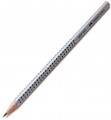Lead Diameter
The thickness of the lead (writing rod) in a pencil or each crayon in a set (see "Product Type").
The meaning of this parameter depends on the specs of the pencil. So, in traditional pencils (lead in the casing), the thickness of the lead determines only the maximum thickness of the line that can be drawn in one pass. In collet models (see above), this parameter is also necessary to search for refill leads: their diameter must correspond to the size of the lead slot of the collet. And interchangeable leads with a diameter of more than 2 mm, usually, also have to be sharpened. However, anyway, each size is good for its tasks: thin leads are convenient for precise small work, and for large volumes of shading, it is desirable to have thicker pencils — they are not only more convenient, but also do not expend so fast.
As for the crayons, their thickness primarily determines the ease of use, as well as compatibility with special collet pencils that play the role of holders.
Lead Length
In most cases, lead length actually refers to the length of the pencil or crayon itself (see "Product Type"). This allows, to a certain extent, to assess both the dimensions and how long the lead will be in use. In collet pencils (see above), this parameter is indicated very rarely — usually, for models for graphite lead thicker than 1 mm. If it is specified, it usually refers to the regular size of the leads produced for this pencil, or the maximum length of the lead that can fit the pencil.
Lead Hardness
The hardness of the lead (writing rod) in a pencil. This parameter is relevant only for graphite pencils (see "Suitable for"); if it is indicated for colour sets, it means that the package includes graphite pencils (or graphite bars) of the appropriate hardness.
In general, the softer the lead, the thicker the lines and more saturate their colour. Accordingly, soft pencils are better for shading, and hard ones are better for thin, neat lines. As for marking, nowadays, the most popular is European designations with the letters H (hard) and B (soft). Such a letter can be supplemented with a number from 1 to 9, the larger the number, the harder the H-pencil and the softer the B-pencil. And the designation HB corresponds to intermediate, medium hardness; these pencils are considered optimal for simple everyday tasks, such as drawing diagrams and graphs in school notebooks.
Casing Material
—
Wood. Common material for traditional disposable pencils, almost never found in other types. The wood is strong enough and at the same time easily gives in to a knife while sharpening.
—
Plastic. Plastic is found only in collet pencils (see above). Its advantages are low cost, light weight and the ability to give such a case almost any colour. In terms of strength, such cases are inferior to metal ones, however, for everyday use, this point is not critical.
—
Metal. Another material found exclusively in collet models. Such pencils are stronger and more reliable than plastic ones, however, they are much more expensive. Their weight depends on the specific alloy, it can be both small and significant.

